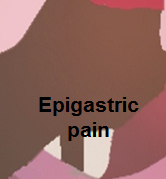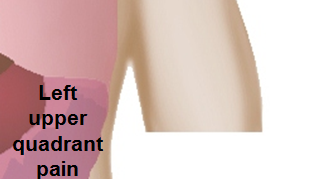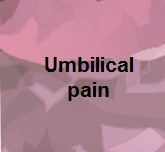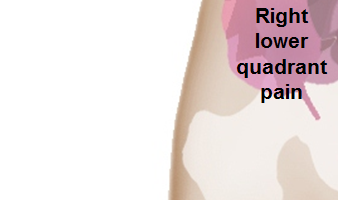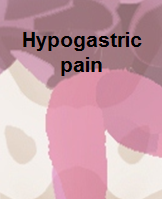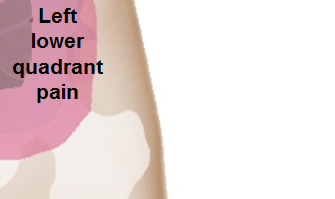Sandbox:Akshun
The following table outlines the major differential diagnoses of abdominal pain.
Abbreviations: RUQ= Right upper quadrant of the abdomen, LUQ= Left upper quadrant, LLQ= Left lower quadrant, RLQ= Right lower quadrant, LFT= Liver function test, SIRS= Systemic inflammatory response syndrome, ERCP= Endoscopic retrograde cholangiopancreatography, IV= Intravenous, N= Normal, AMA= Anti mitochondrial antibodies, LDH= Lactate dehydrogenase, GI= Gastrointestinal, CXR= Chest X ray, IgA= Immunoglobulin A, IgG= Immunoglobulin G, IgM= Immunoglobulin M, CT= Computed tomography, PMN= Polymorphonuclear cells, ESR= Erythrocyte sedimentation rate, CRP= C-reactive protein, TS= Transferrin saturation, SF= Serum Ferritin, SMA= Superior mesenteric artery, SMV= Superior mesenteric vein, ECG= Electrocardiogram, US = Ultrasound
| |||||||||||||||||||||||||||||||||||||||||||||||||||||||||||||||||||||||||||||||||||||||||||||||||||||||||||||||||||||||||||||||||||||||||||||||||||||||||||||||||||||||||||||||||||||||||||||||||||||||||||||||||||||||
The following is a list of diseases that present with acute onset severe lower abdominal pain:
| Disease | Findings |
|---|---|
| Ectopic pregnancy | History of missed menses, positive pregnancy test, ultrasound reveals an empty uterus and may show a mass in the fallopian tubes.[1] |
| Appendicitis | Pain localized to the right iliac fossa, vomiting, abdominal ultrasound sensitivity for diagnosis of acute appendicitis is 75% to 90%.[2] |
| Rupturedovarian cyst | Usually spontaneous, can follow history of trauma, mild chronic lower abdominal discomfort may suddenly intensify, ultrasound is diagnostic.[3] |
| Ovarian cyst torsion | Presents with acute severe unilateral lower quadrant abdominal pain, nausea and vomiting, tender adnexal mass palpated in 90%, ultrasound is diagnostic.[4] |
| Hemorrhagic ovarian cyst | Presents with localized abdominal pain, nausea and vomiting. Hypovolemic shock may be present, abdominal tenderness and guarding are physical exam findings, ultrasound is diagnostic.[4] |
| Endometriosis | Presents with cyclic pain that is exacerbated by onset of menses, dyspareunia. laparoscopic exploration is diagnostic.[4] |
| Acute cystitis | Presents with features of increased urinary frequency, urgency, dysuria, and suprapubic pain.[5][6] |
- Treatment should be initiated promptly once the diagnosis has been made.
- The optimal duration of treatment is not known; controlled data are limited.
- As a general rule, a prolonged course of treatment should be expected.
- Folic acid should be given for at least 3 months and up to 1 year depending on clinical response.
- Antibiotic treatment has been given for periods between 2 weeks and 1 year, but most experience shows good outcomes with 3 to 6 months of treatment.
- Vitamin B12 supplementation is also recommended if symptoms last more than 4 months or in the presence of low vitamin B12 levels, regardless of symptom duration.
Pathology
- Tropical sprue (TS) causes mucosal changes throughout the digestive tract.
- Histopathological analysis shows:
- Marked villous atrophy of small bowel
- Decrease in total absorptive surface area
- Decreased absorption of long-chain fatty acids causes steatorrhea
- Decreased protein absorption
- Protein loss through the leaky mucosal membrane
| Gastrointestinal stromal tumors | |||||||||||||||||||||||||||||||||||||||||||||
| KIT gene mutation | PDGFRA mutation | Wild type (absence of KIT/PDGFRA) | |||||||||||||||||||||||||||||||||||||||||||
| Exon 9,13 & 17 | Exon 11 | Mutant succinate dehydrogenase | |||||||||||||||||||||||||||||||||||||||||||
| Uncontrolled KIT signalling | KIT receptor mutation | Dysfunction of electron transport mitochondria | |||||||||||||||||||||||||||||||||||||||||||
| Defective oxidative phosphorylation | |||||||||||||||||||||||||||||||||||||||||||||
| Abnormal stabilization of HIF | |||||||||||||||||||||||||||||||||||||||||||||
| |||||||||||||||||||||||||||||||||||||||||||||||||||||||||||||||||||||||||||||||||||||||||||||||||||||||||||||||||||||||||||||||||||||||||||||||||||||||||||||||||||||||||||||||||||||||||||||||||||||||||||||||||||||||||||||||||||||||||||||||||||||||||||||||||||||||||||||||||||||||||||||||||||||||||||||||||||||||||||||||||||||||||||||||||||||||||||||||||||||||||||||||||||||||||||||||||||||||||||||||||||||||||||||||||||||||||||||||||||||||||||||||||||||||||||||||||||||||||||||||||||||
RUQ= Right upper quadrant of the abdomen, LFT= Liver function test, SIRS= Systemic inflammatory response syndrome, ERCP= Endoscopic retrograde cholangiopancreatography, N= Normal, AMA= Anti mitochondrial antibodies, LDH= Lactate dehydrogenase, GI= Gastrointestinal, CT= Computed tomography
| |||||||||||||||||||||||||||||||||||||||||||||||||||||||||||||||||||||||||||||||||||||||||||||||||
| |||||||||||||||||||||||||||||||||||||||||||||||||||||||||||||||||||||||||||||||||||||||||||||||||||
| Disease | Signs and Symptoms | Barium esophagogram | Endoscopy | Other imaging and laboratory findings | Gold Standard | |||||||
|---|---|---|---|---|---|---|---|---|---|---|---|---|
| Onset | Dysphagia | Weight loss | Heartburn | Other findings | Mental status | |||||||
| Solids | Liquids | Type | ||||||||||
| Plummer-Vinson syndrome |
|
+ | - | Non progressive | +/- | - | Normal |
|
|
|
Triad of | |
| Esophageal stricture |
|
+ | +/- | Progressive | +/- | +/- | Normal |
|
|
|
| |
| Diffuse esophageal spasm |
|
+ | + | Non progressive | + | + | Normal |
|
|
|
||
| Achalasia |
|
+ | + | Non progressive | +/- | - |
|
Normal |
|
|||
| Systemic sclerosis |
|
+ | + | Progressive | +/- | + |
|
Normal |
|
|
Positive serology for | |
| Zenker's diverticulum |
|
+ | - | +/- | - |
|
Normal |
|
|
| ||
| Esophageal carcinoma |
|
+ | + | Progressive | + | +/- | Normal |
|
|
|||
| Stroke |
|
+ | + | Progressive | + | +/- |
|
Impaired |
|
|
||
| Motor disorders |
|
+ | + | Progressive | +/- | Normal |
|
|
|
| ||
| GERD |
|
+ | - | Progressive | +/- | + | Normal |
|
|
| ||
| Esophageal web |
|
+ | +/- | Progressive | - | +/- |
|
Normal |
|
|
|
|
| Eosinophilic esophagitis | ||||||||||||
polyglandular autoimmune syndrome polyendocrine autoimmune syndrome
tryptophan hydroxylase presenting with malabsorption
- Tyrosine hydroxylase presenting with alopecia areata
- Liver presenting with autoimmune liver disease and chronic active hepatitis
- Steroidal hormone–producing cell presenting with hypogonadism.
X linked polyendocrinopathy, immune dysfunction and diarrhea. This condition is very rare and generally presents in neonatal period with diabetes and malabsorption. Unlike type 1 and type 2 autoimmune polyglandular syndromes there is no association with HLA genotype. Mutation in FOXP3 gene is inherited as X linked and leads to loss of regulatory T cells and autoimmunity.
The term “polyendocrine” itself is a misnomer, in that not all patients have multiple endocrine disorders, and many have nonendocrine autoimmune diseases. Nevertheless, the recognition that patients in whom multiple autoimmune disorders are diagnosed may have a specific genetic syndrome, may be at increased risk for multiple autoimmune disorders, and may have relatives who have an increased risk should spur clinicians toward early diagnosis and treatment.
In the simplest hypothesis for understanding organ-specific autoimmunity, the initial step is the loss of immunologic tolerance to a peptide within a specific molecule found in the target organ. Clones of the CD4 T cells that recognize the peptide then expand, and the specific cytokines produced by the clonal CD4 T cells favor inflammation (as when type 1 helper T [Th1]–cell clones produce cytokines such as interferon-γ) or favor autoantibody-mediated disease (as is the case predominantly with type 2 helper T [Th2]–cell clones).9 The probability of T-cell autoreactivity is determined both in the thymus (the site of central tolerance) and in the periphery (the site of peripheral tolerance) and is strongly influenced by specific HLA alleles
TYPE 1 APS Mutations in the AIRE gene cause many autoimmune diseases, and affected patients are at risk for the development of multiple additional autoimmune diseases over time, including type 1A diabetes, hypothyroidism, pernicious anemia, alopecia, vitiligo, hepatitis, ovarian atrophy, and keratitis. Affected patients may also have diarrhea or obstipation that may be related to the destruction of gastrointestinal endocrine cells (enterochromaffin and enterochromaffin-like cells).39 Knockout of the AIRE gene in the mouse produces widespread autoimmunity, but the phenotype is relatively mild. SYMPTOMS TYPE1 Addison's disease develops in 80 percent of patients with autoimmune polyendocrine syndrome type I, and type 1A diabetes develops in 18 percent
PROGNOSISI TYPE 1 After diagnosis, patients with autoimmune polyendocrine syndrome type I require close monitoring. Monitoring can help prevent illness associated with delayed diagnosis of additional autoimmune diseases (e.g., Addison's disease and hypoparathyroidism, which can develop during adulthood) as well as oral cancer, which may develop if candidiasis is not treated aggressively, and infection due to asplenism, which is present in a subgroup of patients.
- In patients with autoimmune polyendocrine syndromes who have a single disorder such as Addison's disease or type 1A diabetes, the prevalence of additional autoimmune disorders is 30 to 50 times that in the general population.60,61 The concurrence of more than one endocrinopathy presumably results from shared genetic susceptibility leading to loss of tolerance to multiple tissues
TYPE 2
Autoimmune polyendocrine syndrome type II (also called Schmidt's syndrome with Addison's disease plus hypothyroidism) is much more common and more varied in its manifestations than autoimmune polyendocrine syndrome type I.
TYpe 3
X-Linked Polyendocrinopathy, Immune Dysfunction, and Diarrhea. The syndrome of X-linked polyendocrinopathy, immune dysfunction, and diarrhea (known as XPID) is an extremely rare disorder characterized by fulminant, widespread autoimmunity and type 1A diabetes, which usually develops in neonates; it is often fatal. The disorder is also known as XLAAD (X-linked autoimmunity and allergic dysregulation) and IPEX (immune dysfunction, polyendocrinopathy, and enteropathy, X-linked)
Aldosterone Deficiency: Hyporeninemic hypoaldosteronism - Commonly seen in patients with renal insufficiency (diabetic kidney disease, chronic tubulointerstitial disease, or glomerulonephritis) and those that take certain medications (non-steroidal anti-inflammatory drugs, calcineurin inhibitors).[1] Angiotensin inhibitors - angiotensin-converting enzyme (ACE) inhibitors, angiotensin II receptor blockers (ARBs), direct renin inhibitors Heparin therapy (including low molecular weight heparin) - Heparin has a direct toxic effect on the adrenal zona glomerulosa cells which leads to a reduction in plasma aldosterone concentration.[9] Primary adrenal insufficiency (Addison’s disease) - Associated with the lack of cortisol and aldosterone. This can result from autoimmune adrenalitis, infectious adrenalitis, and other disorders.[14] Critical illness - There is decreased adrenal production of aldosterone and stress-induced hypersecretion of ACTH which can diminish aldosterone synthesis by diverting substrate to the production of cortisol. Congenital isolated hypoaldosteronism - Deficiency of enzymes required for aldosterone synthesis.[14] Pseudohypoaldosteronism type 2 (Gordon’s syndrome or familial hyperkalemic hypertension) - Abnormalities in WNK kinases in the distal nephron increase chloride reabsorption leading to reduced renal potassium secretion. Characterized by hypertension, hyperkalemia, metabolic acidosis, normal renal function, and low or low-normal plasma renin activity and aldosterone concentrations.[14][2] Aldosterone Resistance: Inhibitors of the epithelial sodium channel - Most commonly associated with the administation of potassium-sparing diuretics (spironolactone, eplerenone, amiloride) and certain antibiotics (trimethoprim, pentamidine). Pseudohypoaldosteronism type 1 - Characterized by marked elevations of plasma aldosterone levels. There is an autosomal recessive form, and an autosomal dominant or sporadic form. The autosomal dominant form tends to be associated with milder symptoms
| Type of
Adrenal insufficiency |
Skin Pigmentation | ACTH | Normal ACTH |
|---|---|---|---|
| Addison disease | + | >60 ng/mL | 5-30 ng/mL |
| Secondary /
tertiary adrenal insufficiency |
- | <5 ng/mL |
Addison's disease must be differentiated from other diseases that cause hypotension, skin pigmentation, and abdominal pain such as myopathies, celiac disease, Peutz-Jeghers syndrome ,anorexia nervosa, syndrome of inappropriate anti-diuretic hormone (SIADH), neurofibromatosis, porphyria cutanea tarda, salt-depletion nephritis and bronchogenic carcinoma.[7][8]
| Disease | Differentiating symptoms | Differentiating laboratory findings | Gold standard test | ||||||||
|---|---|---|---|---|---|---|---|---|---|---|---|
| Hypotension | Abdominal pain | Anorexia/
weight loss |
Muscle weakness | Hypoglycemia | Skin pigmentation | Other symptoms | Hyponatremia | Cortisol levels | Other labs | ||
| Addison's disease | + | + | + | + | + | + | - | Low | ACTH stimulation test | ||
| Myopathies
hereditary myopathies) |
- | - | - | + | - | Heliotrope rash and
Gottron's sign |
- | Normal | - | Muscle biopsy | |
| Celiac disease | - | + | + | - | - | Dermatitis herpetiformis |
|
- | Normal | - | Abnormal small bowel biopsy |
| Syndrome of inappropriate anti-diuretic hormone | - | - | - | - | - | - | - | + | Normal |
|
Water deprivation test |
| Neurofibromatosis | - | - | + | + | - | Axillary- and inguinal-area freckling |
|
- | - | - | Biopsy of skin tissue |
| Peutz-Jeghers syndrome | + | + |
|
- | Normal | Colonic imaging showing the small intestinal polyps | |||||
| Porphyria cutanea tarda | - | + | - | - | - | Blisters on sun-exposed sites |
|
- | Normal or elevated | High level of porphyrins in the urine | |
| Salt-depletion nephritis | + | Flank pain | - | - | - | - | + | Elevated | <15:1 BUN:CR | ||
| Bronchogenic carcinoma | - | - | + | - | - | + | - | Elevated | Increased ACTH and | Cytological or histological evidence of lung cancer in sputum, pleural fluid, or tissue | |
| Anorexia nervosa | + | - | + | + | + | - |
|
- | Elevated | - | Psychiatric condition |
- ↑ Morin L, Cargill YM, Glanc P (2016). "Ultrasound Evaluation of First Trimester Complications of Pregnancy". J Obstet Gynaecol Can. 38 (10): 982–988. doi:10.1016/j.jogc.2016.06.001. PMID 27720100.
- ↑ Balthazar EJ, Birnbaum BA, Yee J, Megibow AJ, Roshkow J, Gray C (1994). "Acute appendicitis: CT and US correlation in 100 patients". Radiology. 190 (1): 31–5. doi:10.1148/radiology.190.1.8259423. PMID 8259423.
- ↑ Bottomley C, Bourne T (2009). "Diagnosis and management of ovarian cyst accidents". Best Pract Res Clin Obstet Gynaecol. 23 (5): 711–24. doi:10.1016/j.bpobgyn.2009.02.001. PMID 19299205.
- ↑ 4.0 4.1 4.2 Bhavsar AK, Gelner EJ, Shorma T (2016). "Common Questions About the Evaluation of Acute Pelvic Pain". Am Fam Physician. 93 (1): 41–8. PMID 26760839.
- ↑ {{Cite journal | author = W. E. Stamm | title = Etiology and management of the acute urethral syndrome | journal = Sexually transmitted diseases | volume = 8 | issue = 3 | pages = 235–238 | year = 1981 | month = July-September | pmid = 7292216
- ↑ {{Cite journal | author = W. E. Stamm, K. F. Wagner, R. Amsel, E. R. Alexander, M. Turck, G. W. Counts & K. K. Holmes | title = Causes of the acute urethral syndrome in women | journal = The New England journal of medicine | volume = 303 | issue = 8 | pages = 409–415 | year = 1980 | month = August | doi = 10.1056/NEJM198008213030801 | pmid = 6993946
- ↑ Selva-O'Callaghan A, Labrador-Horrillo M, Gallardo E, Herruzo A, Grau-Junyent JM, Vilardell-Tarres M (2006). "Muscle inflammation, autoimmune Addison's disease and sarcoidosis in a patient with dysferlin deficiency". Neuromuscul. Disord. 16 (3): 208–9. doi:10.1016/j.nmd.2006.01.005. PMID 16483775.
- ↑ Kumar V, Rajadhyaksha M, Wortsman J (2001). "Celiac disease-associated autoimmune endocrinopathies". Clin. Diagn. Lab. Immunol. 8 (4): 678–85. doi:10.1128/CDLI.8.4.678-685.2001. PMC 96126. PMID 11427410.

